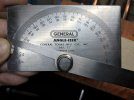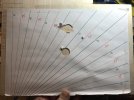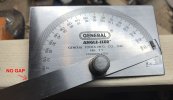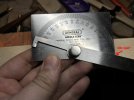You are using an out of date browser. It may not display this or other websites correctly.
You should upgrade or use an alternative browser.
You should upgrade or use an alternative browser.
Measuring angles
- Thread starter pop-pop
- Start date
I don't have a one-tool answer but will tell you what I do. I agree the pictured angle gauge has issues specifically with very acute angles.
What I ended up doing is making a bevel board, designed it in Inkscape and printed out paper and stuck it to plywood on both sides. I use that to set a sliding bevel which I then use for laying out most of the angles on plane bodies. I need to refresh mine because it's been sort of abused so I might take pictures after I am done.
For plane wedges (~10* angles) I draw the angle as two lines in Inkscape and print that out and put it on a flat surface, it helps if you clamp a ruler along one line so you aren't having to align along both edges at once. I have really only used 10* for planes I have made so that's basically one sheet of paper.
I haven't used a wixey style gauge much except for setting the angle on the bevel filing jig I made for carving knives. But I also do not have many proper machines.
I use the veritas bevel gauge for blade bevel angles, although in practice I almost always just need the 25 degree notch and very rarely 35 or 20.
What I ended up doing is making a bevel board, designed it in Inkscape and printed out paper and stuck it to plywood on both sides. I use that to set a sliding bevel which I then use for laying out most of the angles on plane bodies. I need to refresh mine because it's been sort of abused so I might take pictures after I am done.
For plane wedges (~10* angles) I draw the angle as two lines in Inkscape and print that out and put it on a flat surface, it helps if you clamp a ruler along one line so you aren't having to align along both edges at once. I have really only used 10* for planes I have made so that's basically one sheet of paper.
I haven't used a wixey style gauge much except for setting the angle on the bevel filing jig I made for carving knives. But I also do not have many proper machines.
I use the veritas bevel gauge for blade bevel angles, although in practice I almost always just need the 25 degree notch and very rarely 35 or 20.
Top center is my Starrett universal bevel gage. I use it to set my table saw and to measure other angles.

Help us understand why this or the Wixey or a bevel "has serious limitation or flat out doesn’t work"
Unless I'm missing something obvious you cannot take a direct reading of about 15 degrees or less because of the way the tool is designed. The spot you would put the thing to measure closes up. You could use a square block to measure it as 105 degrees instead but that is an extra step.
Attachments
@Scott H you are showing an obtuse angle there at 165if you would rotate that 180 degrees you would have something similar to what @pop-pop is showing or 15 degrees acute... that is what I don't understand - he is getting 28 degrees as a direct reading on his gage...Unless I'm missing something obvious you cannot take a direct reading of about 15 degrees or less because of the way the tool is designed. The spot you would put the thing to measure closes up. You could use a square block to measure it as 105 degrees instead but that is an extra step.
@Hmerkle Sorry, I am being unclear, maybe this is a better illustration of what I'm referring to. I am sure you have used these plenty so I am probably just communicating poorly.
If you have an angle of say 25+ degrees there is the angle formed by the two pieces you can stick something into, so either you set the gauge by closing it on the item and reading, or set it to a reading and look for daylight. When the angle is too small that gap closes up and the best you can do is what I have in the 2nd picture (10 degree angle) which doesn't feel anywhere near as positive/accurate of a reading, compared to things mechanically touching or seeing daylight through a gauge. It's fine for getting kinda close though.
If you have an angle of say 25+ degrees there is the angle formed by the two pieces you can stick something into, so either you set the gauge by closing it on the item and reading, or set it to a reading and look for daylight. When the angle is too small that gap closes up and the best you can do is what I have in the 2nd picture (10 degree angle) which doesn't feel anywhere near as positive/accurate of a reading, compared to things mechanically touching or seeing daylight through a gauge. It's fine for getting kinda close though.
Attachments
For little stuff I use a plastic protractor.
Since I have already borderline hijacked this thread (sorry!) here is a picture of the bevel board I use for planemaking (bed/breast/wear angles, etc.) As you can see it needs to be remade and I've used it as a drill backing board when I was in a hurry but it is possible to get things pretty accurate with a large sliding bevel, printers do a good job reproducing angles accurately.
Attachments
Situations seem to pop up all too often where the bulk of the tool gets in the way of making the measurement. To be expected I guess since some sort of swivel is needed.Help us understand why this or the Wixey or a bevel "has serious limitation or flat out doesn’t work"
I find myself doing more of what @Scott H does by printing a “gauge” on paper from a CAD program. Here is one that I did today and I had more confidence than measuring that obtuse angle with a metal tool.
My query here is to make sure that I am not missing out on some clever tool.
I use a angle reference plate from Woodpeckers. I use a Woodpeckers adjustable bevel gauge (took 3 tries to get one that worked correctly). The drawback is the size of the bevel angle (12") but it can measure what you are showing Pop-pop. The angle gauge bar is demarcated in .025 degree increments and hangs on the side of one of my cabinets for quick access.

 www.woodpeck.com
www.woodpeck.com
And, then there is operator error.

OneTIME Tool - Bevel Gauge & Angle Reference Plate 2016 - Retired July 18, 2016
One of Our Best Tools, Ever!A Simple Tool Beautifully Rendered. Some tools are special. You get a good feeling just holding them. Maybe the tool was handed-down from your dad. Or, the tool is perfect in design and function. In use, it becomes an extension of your hand. Woodpeckers Precision...
And, then there is operator error.
I have some really good angle measuring tools, but if I need something accurate to less than 1 degree I don’t trust any of them. Like you and others I will draw it in a Cad program. However I don’t trust a print-out either. I will use the numbers from my cad layout and draw it out with 2 legs being a minimum of 24” or whatever it takes to exaggerate the geometry.My query here is to make sure that I am not missing out on some clever tool.
Last edited:
RIGHT!@Hmerkle Sorry, I am being unclear, maybe this is a better illustration of what I'm referring to. I am sure you have used these plenty so I am probably just communicating poorly.
If you have an angle of say 25+ degrees there is the angle formed by the two pieces you can stick something into, so either you set the gauge by closing it on the item and reading, or set it to a reading and look for daylight. When the angle is too small that gap closes up and the best you can do is what I have in the 2nd picture (10 degree angle) which doesn't feel anywhere near as positive/accurate of a reading, compared to things mechanically touching or seeing daylight through a gauge. It's fine for getting kinda close though.
But don't use it that way...
Use the long end of the measuring arm to create an acute angle like @pop-pop did and take the measurement on the other side of the protractor:
Use this. I've had a version in service for more than 20 years. It has a vernier function for sub-degree settings, but I've not checked that function for accuracy.
RIGHT!
But don't use it that way...
Use the long end of the measuring arm to create an acute angle like @pop-pop did and take the measurement on the other side of the protractor:
View attachment 224693
Sorry again, I think we must be talking past each other!
I am not saying the original photo is displaying a problem, it is clearly functioning to read 28 degrees. That's fine. I agree.
I am saying one of the limitations of these types of gauges, separate from the specific photo, is angles that are about 17 degrees or less cannot be measured very accurately, because there is no gap between the two parts to put the part in. Angles in the < 25 degree range are also difficult to measure because the gap gets increasingly tiny compared to typical tool bevels.
Attachments
I actually have a bunch of machinist angles roughly 3" long in these degrees 1°,2°,3°,5°,7°,10°,20°,22.5°,30°, 37.5°, 45°, 60°. I got them @ a machinist tool auction few years ago, had no idea what they were, They do come in handy. However, The items shown above by Mike and Martin are usually my go to.
Last edited:
Lee Valley makes a bevel reference plate
 www.leevalley.com
www.leevalley.com
Veritas Bevel Setter - Lee Valley Tools
Discover the Veritas Bevel Setter. Buy this product now on our Lee Valley online store.
I don't find the type gauges @pop-pop shows to be very useful. I guess it all depends on what you're measuring.
In woodworking I use a12" Igaging digital bevel for setting up a table saw bevel or a miter gauge. I find it very accurate.

I use one of these to set up a honing jig.

A reference plate like this one is very accurate.

In woodworking I use a12" Igaging digital bevel for setting up a table saw bevel or a miter gauge. I find it very accurate.
I use one of these to set up a honing jig.
A reference plate like this one is very accurate.
Use the long end of the measuring arm to create an acute angle like @pop-pop did and take the measurement on the other side of the protractor:
@Scott H He's talking about using the obtuse angle formed on the other side of the protractor arm to measure the angle from the opposite side of the piece being measured.
@Hmerkle That can work, but it will only be accurate if the reference surfaces that you're measuring from are parallel.
All depends on what you want to measure or copy and how accurate.
I use a General digital protractor. Good enough. Usually, I only want to copy an angle so just use my sliding bevel gauge. Value not important.
I have a Wixi cube I try to use on the TS, but the slightest off square, it reads wrong. Normally I just want a 45 or 90 so I use my Japanese square.
Some layout, I just use an old plastic round protractor.
I use a General digital protractor. Good enough. Usually, I only want to copy an angle so just use my sliding bevel gauge. Value not important.
I have a Wixi cube I try to use on the TS, but the slightest off square, it reads wrong. Normally I just want a 45 or 90 so I use my Japanese square.
Some layout, I just use an old plastic round protractor.






